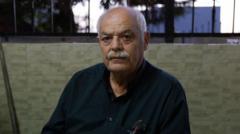With nearly 10 million residents, Tehran's density mirrors that of New York City. Recent evacuation orders by Israel as they target critical infrastructure amid ongoing military operations have left many residents scrambling for safety, causing widespread congestion and fear within the capital.
Escalating Tensions in Tehran: Israel's Evacuation Warnings Amid Strikes

Escalating Tensions in Tehran: Israel's Evacuation Warnings Amid Strikes
As Israeli attacks intensify, concerns rise for Tehran's densely populated neighborhoods. Many residents are urged to evacuate amidst fears of imminent strikes.
In recent days, tensions have drastically escalated in Tehran, coinciding with increased military actions by Israel and urgent evacuation warnings impacting the city’s residents. Over the week, Israel has expanded its airstrikes targeting Iranian military infrastructure believed to support its nuclear capabilities, particularly in densely populated neighborhoods.
Tehran’s population density, at approximately 10 million residents within around 300 square miles, is comparable to New York City's, making the situation particularly dire given the scale of potential civilian impact. Notably, about one in ten Iranians resides in the capital, indicating that a significant portion of the country's population is directly affected by the unfolding conflict.
Cars lined long at gas stations and streets were congested in recent scenes captured around the city as residents attempted to flee amid growing panic. The Israeli military issued an evacuation order specifically for District 3, an affluent area with several hundred thousand inhabitants, prompting a heightened state of alarm. President Donald J. Trump echoed concerns in a Truth Social post, urging all Tehran residents to “immediately evacuate.”
Further complicating the scenario, Israelis issued another evacuation alert that encompassed parts of District 18—an area located near the Mehrabad International Airport and characterized as one of Tehran's poorer neighborhoods. Reports verified that strikes targeted both densely populated residential zones, including in the cities of Tabriz and Mashhad, and less populated areas like Natanz, home to critical uranium enrichment facilities.
As the situation unfolds, concerns about civilian safety have become paramount, with many Tehran residents caught between military actions and the urgent need for safety. The ramifications of these developments are likely to resonate well beyond Tehran's borders, further complicating an already volatile regional landscape.
Elena Shao, a reporter and graphics editor based in New York, continues to monitor and report on this critical situation, bringing clarity to the ongoing conflict.
This article invites readers to consider the perspectives surrounding both the Iranian populace and the geopolitical tensions stirring in this historic region.
Tehran’s population density, at approximately 10 million residents within around 300 square miles, is comparable to New York City's, making the situation particularly dire given the scale of potential civilian impact. Notably, about one in ten Iranians resides in the capital, indicating that a significant portion of the country's population is directly affected by the unfolding conflict.
Cars lined long at gas stations and streets were congested in recent scenes captured around the city as residents attempted to flee amid growing panic. The Israeli military issued an evacuation order specifically for District 3, an affluent area with several hundred thousand inhabitants, prompting a heightened state of alarm. President Donald J. Trump echoed concerns in a Truth Social post, urging all Tehran residents to “immediately evacuate.”
Further complicating the scenario, Israelis issued another evacuation alert that encompassed parts of District 18—an area located near the Mehrabad International Airport and characterized as one of Tehran's poorer neighborhoods. Reports verified that strikes targeted both densely populated residential zones, including in the cities of Tabriz and Mashhad, and less populated areas like Natanz, home to critical uranium enrichment facilities.
As the situation unfolds, concerns about civilian safety have become paramount, with many Tehran residents caught between military actions and the urgent need for safety. The ramifications of these developments are likely to resonate well beyond Tehran's borders, further complicating an already volatile regional landscape.
Elena Shao, a reporter and graphics editor based in New York, continues to monitor and report on this critical situation, bringing clarity to the ongoing conflict.
This article invites readers to consider the perspectives surrounding both the Iranian populace and the geopolitical tensions stirring in this historic region.






















